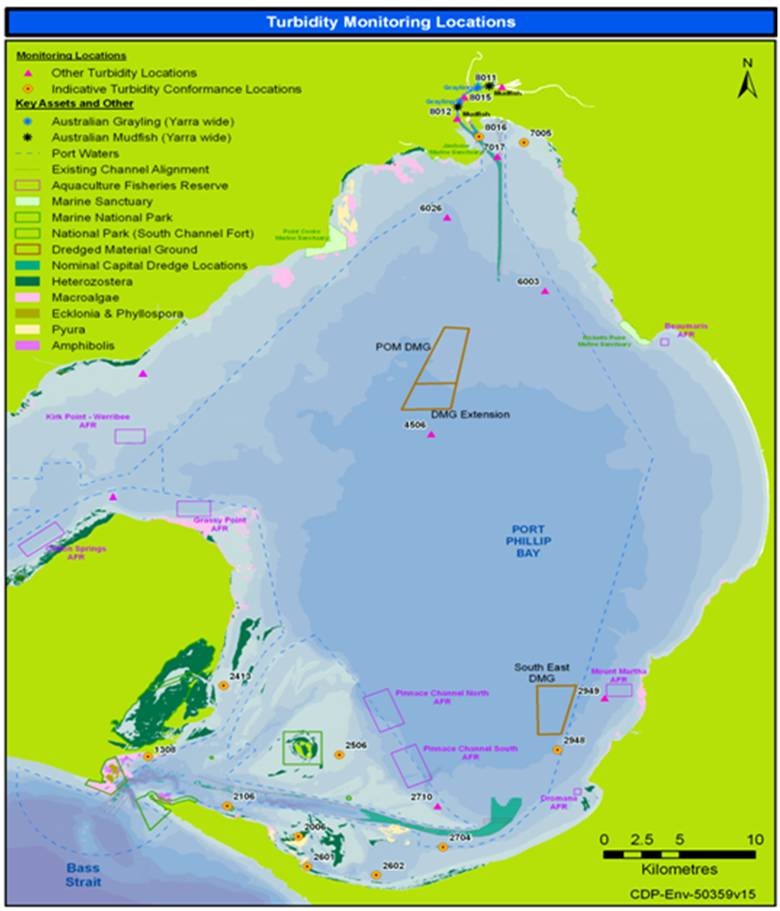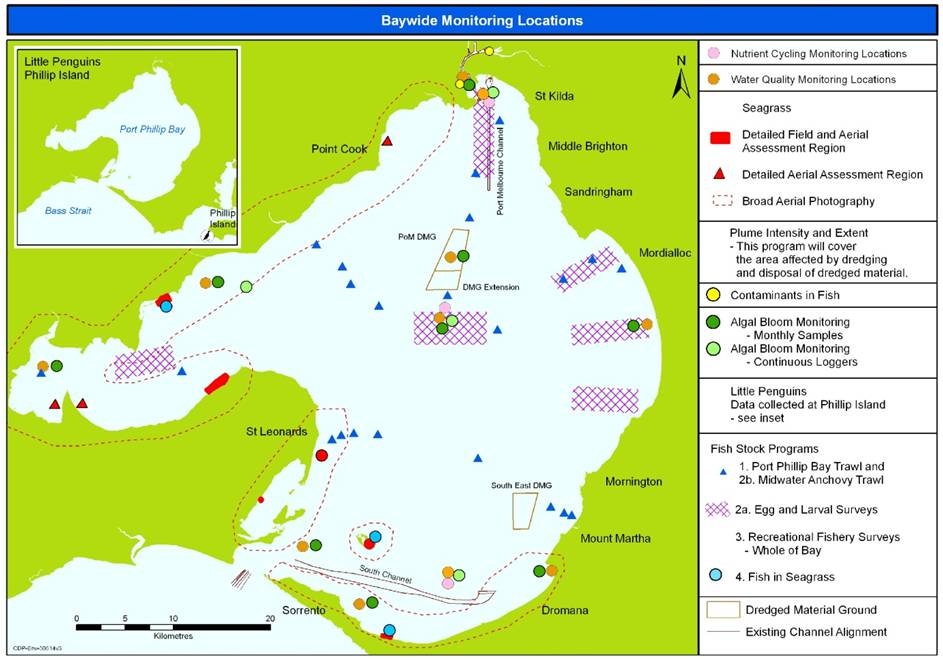Construction
The final risk assessment of the SEES (Environmental Effects Statement) included the findings of the environmental impact assessments and formed the basis for the environmental monitoring plan (EMP). The EMP contains the details of the environmental requirements, in particular equipment standards, monitoring programmes, regulatory control, reporting requirements and communication measures and applies to all capital works and environmental monitoring programmes.
Two monitoring programs
Two different monitoring programs were executed. The first one is the compliance monitoring, being continuous daily turbidity monitoring of the turbidity. The second is a bay-wide monitoring programme focused on key species, habitats and ecological processes. The data from this programme was reviewed every six months and if necessary were used to adjust the environmental limits.
Compliance Monitoring
Compliance monitoring was meant to show that all criteria and requirements were met. All vessels were equipped with vessel tracking systems to ensure compliance with dredged material management demands, which included limits to the quantity of material to be dredged and to the vertical and horizontal tolerances, as well as to the time frame for dredging at certain locations (e.g. not during spawning and migration periods or peak holiday seasons). Turbidity and vessel position were monitored automatically and transmitted to a database at the office.
Boskalis managed the data flow and guarded the data integrity, which was a fully transparent process that was audited regularly. The data could be visualised via a web page. Strict requirements demanded the immediate reporting in case of threshold exceedances (e.g. turbidity), non-compliances and other incidents and hazards.

Compliance for turbidity was based on NTU values of 6-hourly Exponentially Weighted Moving Average (EWMA). Based on the measured turbidity results, the work method of the TSHDs could be adjusted whenever necessary. For management purposes, two response levels were defined to enable early and consistent response if the measured turbidity levels were increasing. The level 1 response was typically an investigation into the nature and causes for the trigger, level 2 required management actions to reduce suspended sediment concentrations.
Typical management actions of this kind were moving the dredger to another location, dredging with no overflow, or dredging at reduced speed. In fact, this was done pro-actively, such that the actual environmental limit would never be reached. Adjustments to the work method were only necessary during strong winds when elevated levels of turbidity occurred and it was decided to move the TSHD to a different dredging area.
A video survey of the Entrance was conducted as part of the compliance monitoring scheme. A clean-up procedure was applied at the Entrance, to ensure that any residual rock was removed and could not damage the sponges and corals. A special data analysis tool applied to the vessel tracking system was used to prove that the operations proceeded in accordance with the EMP.
The contaminated silt in the Yarra River was dredged using a TSHD. Extensive survey efforts and draghead tracking was required to prove that 100% of the contaminated silt had been removed. No mixing with the ambient water occurred, no dredged silt was found outside the disposal area and water quality was not affected.
The total costs of the compliance monitoring programme amounted to about 10% of the construction costs.
Bay Wide Monitoring Program
PoMC conducted several bay-wide monitoring programmes to provide broader information on the status of key species, habitats and ecological processes in the Bay. Nine such programmes were developed, concerning Seagrass, Water Quality, Nutrient Cycling (denitrification), Contaminants in Fish, Algal Blooms, Little Penguins, Fish Stock & Requirement, Ramsar Wetlands and Plume Intensity & Extent, respectively.
All of the programs, except the Plume Intensity & Extent program, monitored key assets and ecological processes. The results of these monitoring programmes were reviewed quarterly and laid down in a Bay-wide Monitoring Report. This review provided a ‘snapshot’ of the status of the bay as a whole and was incorporated into the six monthly environmental management reviews.
As part of the Bay-wide Monitoring Program, Boskalis conducted the Plume Intensity & Extent monitoring programme. This was an overarching programme to confirm that the plume during dredging was not significantly different from the modelled conditions underlying the risk assessment. Turbidity was measured by sailing tracks in each dredging area during at least 14 consecutive days. This meant that plume monitoring was conducted during 117 days, covering a distance of 4,400 km. A streamer with 2 or 3 turbidity sensors was towed along straight tracks across the dredging area. The streamer could be automatically raised and lowered in the water column by means of a winch.
The monitoring results were reviewed every 6 months by comparing the field data with the model predictions. Differences between modelled and actual plume characteristics were monitored and assessed in terms of risk to assets from turbidity. Thus turbidity limits could have been adjusted to meet the criteria, though in reality none of the environmental limits had to be adjusted after these reviews.

Monitoring reports
Dredging performance was compared to the limits set by the EMP, which was reported weekly to PoMC. However, exceedances, non-compliances and other incidents and hazards were required to be reported immediately, also to the Government. An extensive audit schedule was put in place by the Government with 12 audits to check compliance with the EMP of the vessels, the different dredging activities and the monitoring. Only a few minor non-conformities were found.
Furthermore, PoMC had the obligation to provide quarterly and annual reports to the Government. These contained a summary of all construction activities, project progress, communications with the public and media, notification of the Government, training, reports, incidents and the results of all monitoring programmes, internal and external audits, risk assessments and management reviews. All notifications and reporting to the Government were publicly accessible through the websites of both PoMC and the Government.
Dealing with project changes
Changes to the project had to follow a strict procedure to manage and identify consequences. This applied to changes to the project schedule, work methods, environmental monitoring response levels, project description and dredging technology. The change management process also included a re-assessment of the risk and a check on compliance with the legal requirements; occasionally additional turbidity modelling was required to support the risk assessment. If the change required the EMP to be revised, the Government had to be notified and approval was required for major revisions.
